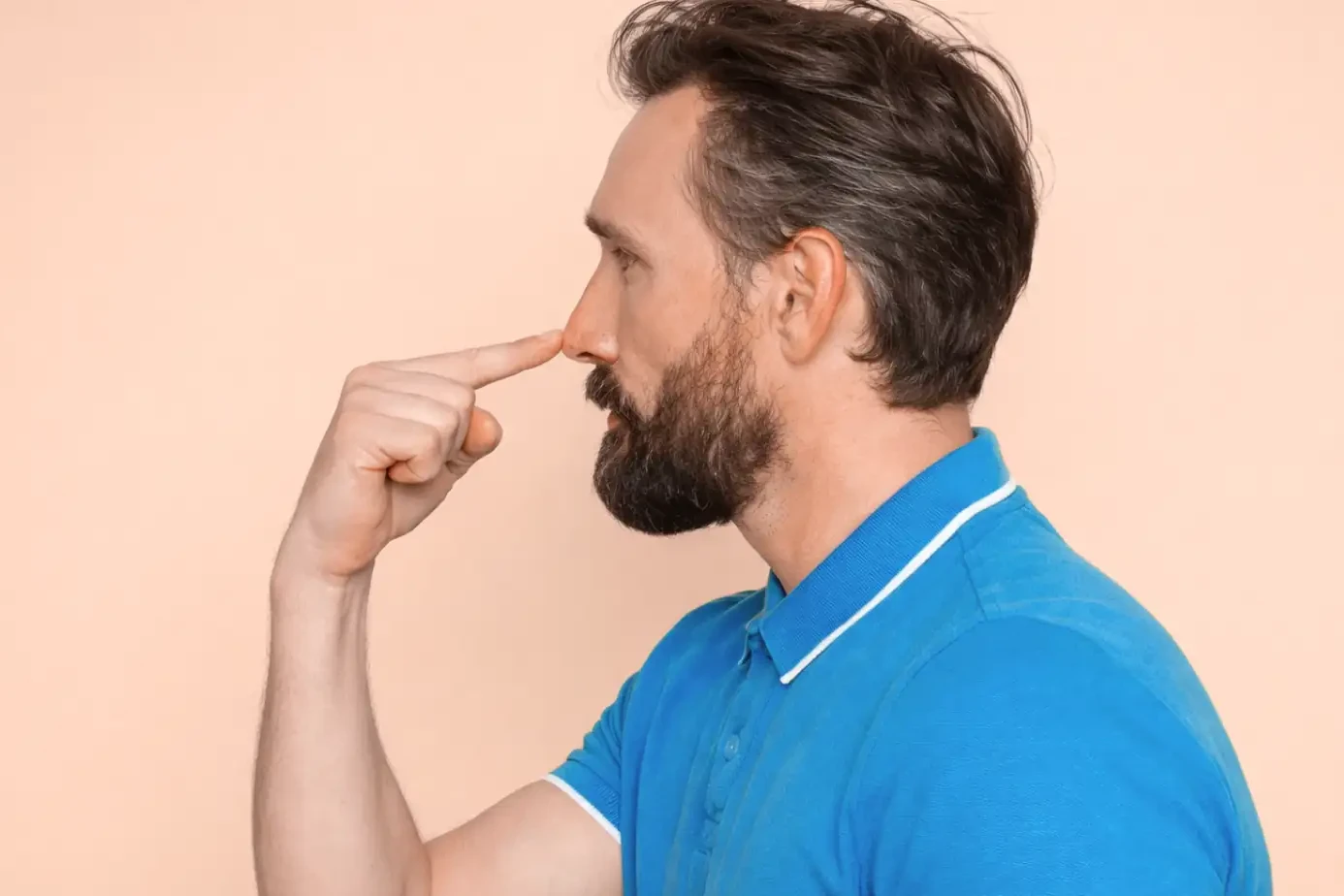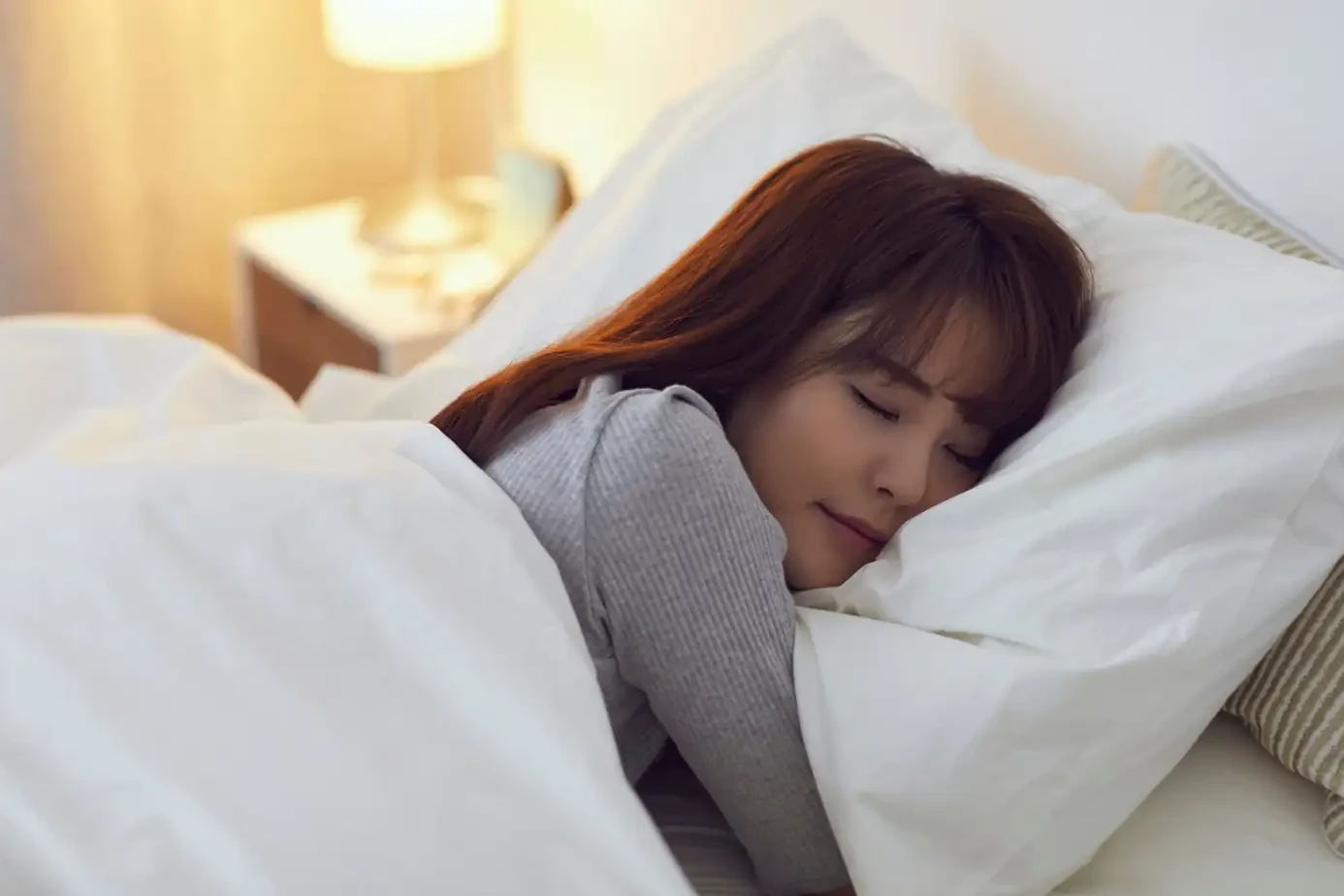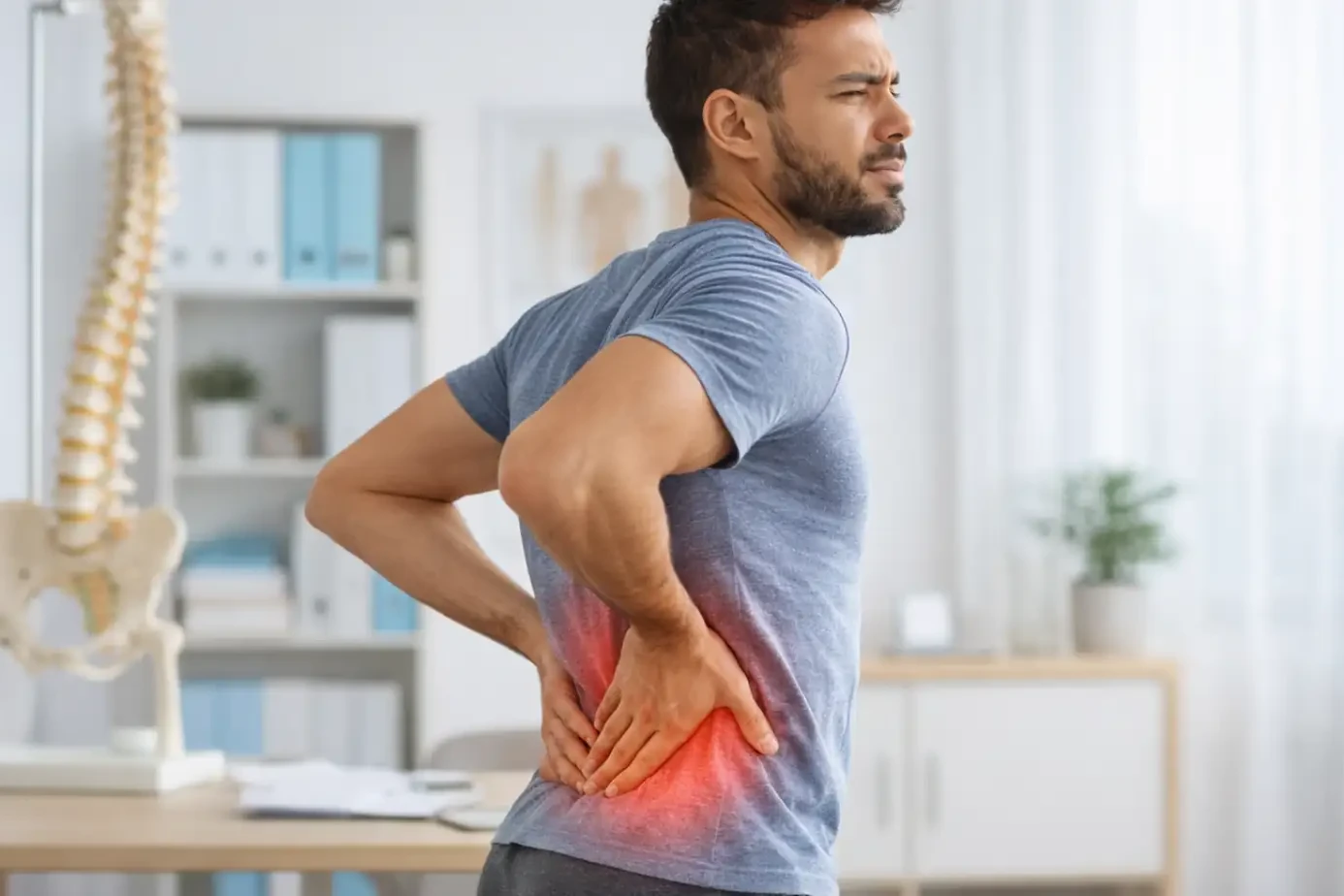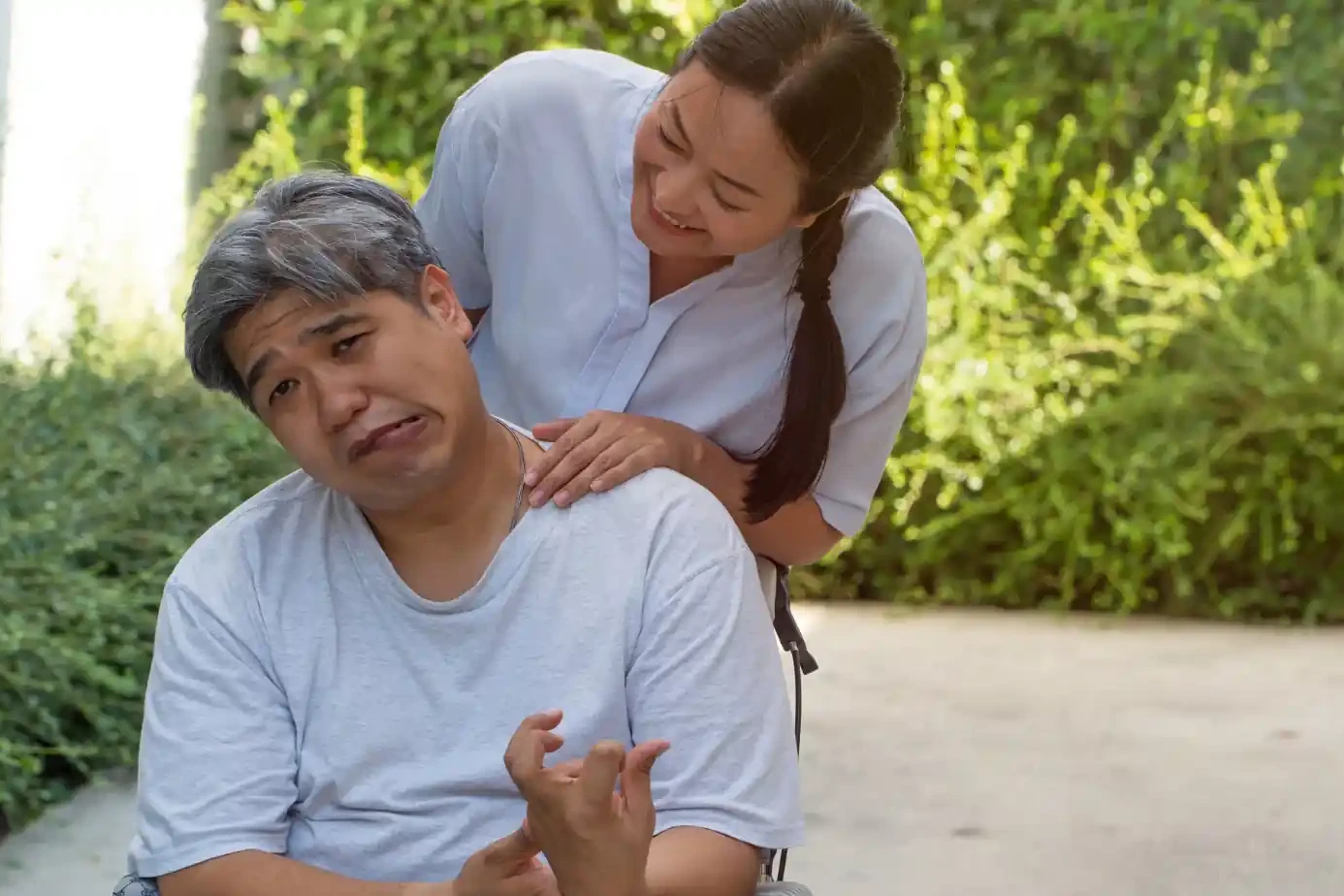Spinal stenosis happens when nerve roots get pressed in the spine. This often causes pain, weakness, and numbness. Different parts of the spine can get affected, leading to various symptoms. Sadly, we can’t always tell who will feel the symptoms as they grow older. Luckily, simple lifestyle changes can help slow down the process.
When the spinal canal narrows and nerve roots get squeezed, it’s called spinal stenosis. This makes pain, weakness, and numbness show up. Learning about what causes it and how to deal with the symptoms is key to handling this issue.
Table of Contents
ToggleIntroduction to Spinal Stenosis
Definition and Overview
Spinal stenosis happens when the nerve roots in the spine are pressed by various issues. This pressure causes pain, numbness, and weakness. The neck and lower back are often affected, but the middle back can also have this issue, usually due to a herniated disk.
Prevalence and Epidemiology
In the U.S., spinal stenosis is common, especially among older adults visiting the doctor’s office. Around 1 out of every 1000 people over 65 and 5 out of every 1000 people over 50 might get it. It is expected that over 18 million Americans will have this condition in the next decade.
Causes of Spinal Stenosis
Spinal stenosis can come from birth defects or happen over time. Only a small number, 9%, are due to being born with certain conditions. Knowing these causes helps doctors treat patients better.
Congenital Causes
Cases of spinal stenosis from birth issues can be because of several conditions. These include achondroplasia and other structural problems. These issues make the spinal canal narrow, putting people at risk for spinal stenosis from an early age.
Acquired Causes
Spinal stenosis can also happen later in life. This might be due to injuries, aging, or medical procedures. Injuries that impact the spine can cause spinal stenosis. So can wear and tear over time. This includes things like disk herniation and the growth of soft tissues within the spine.
Degenerative Changes
The main reason for spinal stenosis is the breaking down of the spine as we age. Arthritis plays a big role. It can lead to the narrowing of the spinal canal. This puts pressure on the nerves in the spine, causing pain and other problems.
what is spinal stenosis
Understanding the Condition
Spinal stenosis is when the spinal canal narrows and puts pressure on the spinal cord. This narrowing can pinch the spinal cord and nerves, affecting how your body works. Many things can cause this, like a bulging disc or too much growth on the spine’s bones.
Types of Spinal Stenosis
Spinal stenosis can happen in the neck, chest, or lower back. It’s most often found in the lower back and neck. Things like getting older or having an injury can lead to this problem.
Symptoms of Spinal Stenosis
Spinal stenosis is when the spinal canal gets narrow. The symptoms change based on where and how bad the compression is. Knowing these signs helps find and treat the problem early.
Cervical Spinal Stenosis Symptoms
When the cervical spine narrows, it can press on nerves or the spinal cord. This might cause neck or arm pain at first. Over time, you might feel numb, weak, or have trouble balancing.
Lumbar Spinal Stenosis Symptoms
If the lumbar spine narrows, it can lead to leg pain during walking that gets better with rest. This can also cause weakness or odd sensations in the legs.
Cauda Equina Syndrome
If spinal stenosis gets very bad, it could lead to cauda equina syndrome. This is an emergency if you lose control over your bathroom functions, have severe leg numbness, and find it hard to walk or stand. Immediate treatment is necessary to avoid lasting nerve damage.
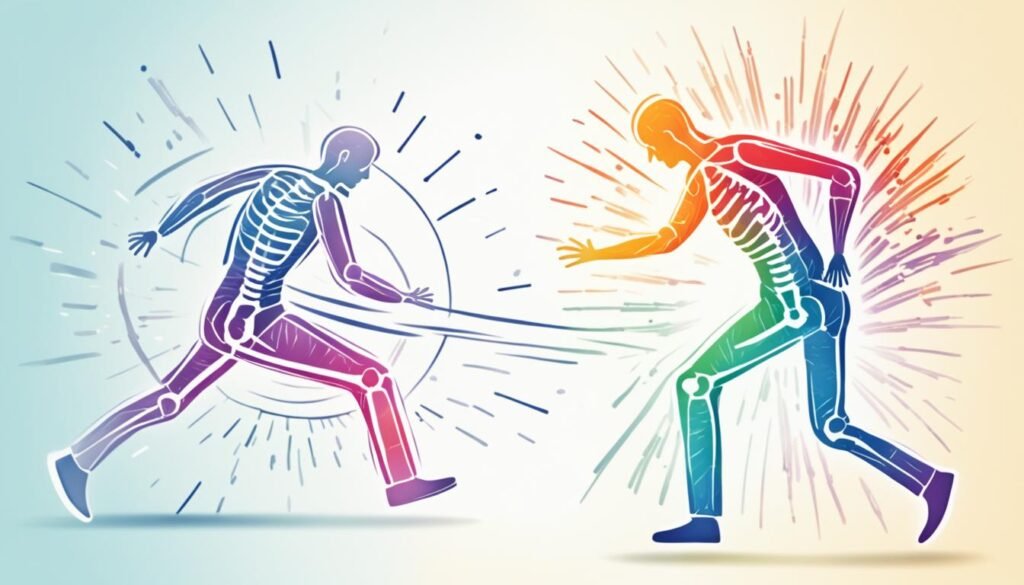
Diagnosis of Spinal Stenosis
Finding out if you have spinal stenosis starts with a close look at your symptoms and how you’re feeling. Your doctor will ask you a lot of questions about your health and what you’re going through. They will then check you over, paying close attention to how you move, feel, and react. This involves looking at the way you walk and testing your strength and reflexes.
Physical Examination
Next, your provider will test how well your body moves, the strength in your muscles, and your nerves. They might do special tests like raising your leg while you lie down, or having you stand still with your eyes closed. These can help figure out the cause of your symptoms. They’ll also check how you stand, your reflexes, and your walk. This is to see if there are any signs of spinal stenosis.
Imaging Tests
After the exam, your doctor could ask for more tests to pin down spinal stenosis. These might include an x-ray you move through, a CT scan, or MRI. MRI is often the most helpful. It gives clear images that show how much your spine has narrowed. It also spots any changes in the structure of your spine, which can all help in making a diagnosis.
Additional Diagnostic Tests
Along with imaging, your medical team might suggest electric tests to study how your nerves are working. These tests can add more clues to what’s causing your issues. They shed light on your nerve health, aiding in the development of a treatment plan.
Treatment Options for Spinal Stenosis
If you’ve been diagnosed with spinal stenosis, your doctor will go through treatment options with you. They aim to ease your symptoms and stop the condition from getting worse. Treatments fall into two main groups: conservative treatments (non-surgical) and surgeries.
Conservative Treatment
For those with spinal stenosis in the neck but not compressing the spinal cord, doctors first try non-surgical methods. This includes using a brace, resting, and taking NSAIDs to lessen pain and swelling. If spinal cord compression occurs (myelopathy), surgery to decompress the spine might be needed to ease pain and prevent further myelopathy.
In the lower back, initial treatments often involve NSAIDs and physical therapy for the pain. If the pain continues, your doctor might suggest shots of steroids into the spine to reduce swelling and pain.
Surgical Procedures
If conservative treatments do not work, or you begin to have more severe symptoms or spinal instability, surgery could be necessary. The types of surgery for spinal stenosis are:
- Decompression surgeries, like laminectomy, to make more space in the spinal canal
- Discectomy, to fix a herniated or bulging disc
- Spinal fusion, to stabilize the spine
- Foraminotomy, to expand the nerve openings in the spine
- Minimally invasive surgery, which means less scarring and quicker recovery
Your doctor will help you decide on the best plan, looking at your symptoms, how severe the condition is, and your lifestyle.
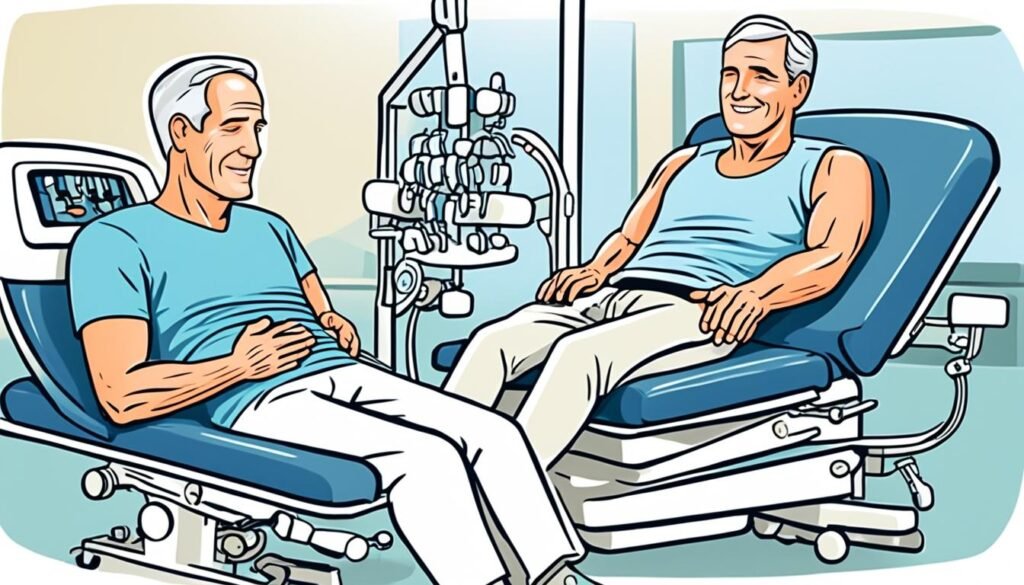
Spinal Stenosis Treatment
Treating spinal stenosis involves various options. These aim to tackle the causes and symptoms. Your team might suggest both non-surgical and surgical methods. They’ll choose based on how bad your stenosis is and how you respond to treatment.
Non-surgical treatments include physical therapy, drugs, and certain pain relief techniques. Physical therapy strengthens your spine’s support muscles. It also boosts your flexibility and endurance. Doctors may also give you drugs like NSAIDs, antidepressants, and opioids to lessen pain.
For more serious cases, or if non-surgical methods don’t help, surgery could be the next step. Operations like a laminectomy create more room in your spine. This eases the pressure on your nerves. Sometimes, spinal fusion surgery is needed for stability.
Working closely with your healthcare team is key in finding the best treatment. They will guide you through your options, explaining both risks and benefits. Together, you’ll make a plan to handle your spinal stenosis effectively.
Risk Factors and Prevention
Spinal stenosis is common and knowing the risks can help prevent it. Most cases occur after age 50. But, younger people with spine issues like scoliosis are at risk too.
Age-Related Risk Factors
The spine naturally wears as we get older. This can cause spinal stenosis. It often comes from spine arthritis. Sometimes, tumors in the spine can lead to it too.
Lifestyle Factors
Bad habits can also make spinal stenosis worse. For example, arthritis may cause extra bone growth. This can press on the spine. To help prevent or slow this, stay at a healthy weight, exercise, and mind your posture.
Preventive Measures
Some spinal stenosis risks, like age, can’t be changed. But, you can cut other risks by not smoking, staying fit, and exercising. It’s also key to catch it early and work with your doctor for a treatment plan.

Cervical Spinal Stenosis
Cervical spinal stenosis happens when the spinal canal in the neck area gets narrow. It compresses the nerve roots and spinal cord. This leads to symptoms that make life hard.
Causes and Symptoms
The main causes are the wear and tear of aging. This includes things like herniated discs and thickening of joints and ligaments. These changes make the spinal canal smaller over time. People with cervical spinal stenosis often feel pain in their neck or arms. They also have issues like numbness, tingling, and weak muscles. In severe cases, myelopathy can develop, causing more serious problems.
Treatment Options
The way to treat cervical spinal stenosis depends on how bad it is. It also depends on how well someone responds to basic treatments. Sometimes, using a brace, taking anti-inflammatory drugs, and doing physical therapy can help. But if these methods don’t work, or things get worse, surgery might be the next step. There are various surgical options, like decompression surgery or spinal fusion, to ease symptoms and improve quality of life.
By learning about what causes cervical spinal stenosis, its symptoms, and treatment options, people can work with their doctors. Together, they can create a plan to manage the condition and lead a better life.
Lumbar Spinal Stenosis
Lumbar spinal stenosis affects the lower back, specifically the lumbar spine. It’s when the spinal canal narrows, squeezing nerve roots and the spinal cord. This can cause pain in the back and legs, making it hard to walk or stand.
Causes and Symptoms
Mostly, lumbar spinal stenosis is due to osteoarthritis, which slowly narrows the spinal canal. People usually feel a cramping pain in their leg, calf, or buttocks. They might also have back pain and lose feeling in their feet, or feel weakness and numbness in their legs.
Sometimes, it can cause a severe problem called cauda equina syndrome. This leads to a loss of control over the bowel or bladder, along with severe leg numbness and weakness. It needs quick medical help.
Treatment Options
Treatments may involve physical therapy, medications, and interventional procedures to manage pain. The goal is to make symptoms better and function improve.
If these don’t work or if symptoms get worse, surgery may be suggested. Operations can include removing bone spurs or fusing vertebrae to create more space.
To diagnose lumbar spinal stenosis, doctors use X-rays, CT scans, and MRI scans. These tests show how bad the narrowing is and help decide the best treatment.
Staying at a healthy weight, regular exercise, maintaining good posture, and not smoking can lower your risks. Although there’s no cure for lumbar spinal stenosis, you can manage it with your doctor’s help.
Cauda Equina Syndrome
Symptoms and Urgency
Cauda Equina Syndrome (CES) is very serious. It leads to symptoms such as not being able to fully empty your bladder (urinary retention) and losing control of the bladder or bowels (urinary and fecal incontinence). Other signs include feeling things differently or not at all in your bottom area, and weak or paralyzed legs. Back and leg pain, and issues with sex are also common.
CES is a medical emergency. It needs quick treatment to avoid lasting harm. Such harm could be permanent leg weakness or not being able to move, and the loss of bladder or bowel control.
Emergency Treatment
For CES, quick surgery is key. It should happen within 48 hours of the symptoms starting. This surgery aims to take off the pressure on the spinal nerves, stopping later harm. It can help a lot in improving the person’s feeling and movement in their legs.
After the emergency surgery, ongoing care is crucial. This usually includes working with a rehabilitation team. It’s to help the patient cope with lasting symptoms and get back to regular life as much as possible.
The impact of CES isn’t just physical. It can change your daily life and relationships. Doing things with friends and family is important when handling CES. Support from those close to you can make a big difference.
Plus, medicine, exercise, and therapy to talk through your feelings can help manage the pain and stress of CES.
Living with Spinal Stenosis
Spinal stenosis heavily impacts many people over 50. It’s key to look at many ways to ease pain, change habits, and find help. This helps make life better while dealing with this condition.
Pain Management Strategies
Easing spinal stenosis pain is very important. Meds like acetaminophen or NSAIDs are often used. Physical therapy is also a great option. It can help you move better, get stronger, and keep more flexible. Alternative methods like acupuncture could also help.
Lifestyle Modifications
Changing how we live can really help with spinal stenosis. Keeping a healthy weight, being active, and sitting/standing correctly can ease stress on the spine. These steps can really slow down how fast the condition gets worse. It helps especially for women, those with narrow spinal canals, or previous spinal issues or surgeries.
Support Resources
Spinal stenosis can be tough, but you’re not alone. Talking to others in support groups and learning from materials can make a big difference. These things can help you learn more about your condition, find treatment choices, and meet people who share your experiences.
Using different strategies, lifestyle changes, and support can help a lot. Remember, while spinal stenosis can’t be fully cured, it can be managed. With a good approach, you can ease symptoms and still lead an active life.
Conclusion
In conclusion, spinal stenosis is when the spinal canal gets narrow. This can squeeze nerve roots and the spinal cord. It can happen in different parts of the spine. Symptoms include pain, numbness, weakness, and trouble walking called neurogenic claudication.
The diagnosis for spinal stenosis uses physical exams, imaging tests, and nerve studies. Treatments include physical therapy and medicine. For severe cases, surgery might be needed. Knowing about the condition and its treatments helps you and your doctor manage it. This improves your life quality.
Spinal stenosis often affects those over 50. Being mindful of the symptoms is crucial. With proper medical care and lifestyle changes, controlling spinal health is possible. This aids in keeping an active life.
FAQ
What is spinal stenosis?
Spinal stenosis happens when nerve roots are pressed, causing pain and other issues.
What causes spinal stenosis?
It can be from birth or happen later in life. Birth issues like achondroplasia can lead to it. Later causes include injuries, wear and tear, and general body problems.
What are the symptoms of spinal stenosis?
Symptoms vary. But often there’s pain in the back or neck, along with numbness, tingling, and weak arms or legs.
How is spinal stenosis diagnosed?
Doctors check you physically and might take X-rays or do MRI scans. They might also check how your nerves work using special tests.
What are the treatment options for spinal stenosis?
Treatment mixes exercise, medicine, and maybe surgery, depending on how bad it is.
What is the difference between cervical and lumbar spinal stenosis?
Cervical spinal stenosis is in the neck. It can cause arm problems. Lumbar stenosis is lower, leading to leg trouble.
What is cauda equina syndrome, and why is it a medical emergency?
Cauda equina syndrome from spinal stenosis is very serious. It can lead to not controlling the bowel or bladder, along with leg issues. It needs quick care to avoid lasting nerve problems.
What are some risk factors for developing spinal stenosis?
Aging, injuries, and some health problems raise the risk of spinal stenosis. But, keeping fit, a good posture, and no smoking can lower your chances.
How can I manage my spinal stenosis symptoms?
You can deal with the symptoms using medicine, exercise, and by keeping a healthy lifestyle and posture. And, finding support can be very helpful.
Source Links
- https://www.ncbi.nlm.nih.gov/books/NBK441989/
- https://www.hopkinsmedicine.org/health/conditions-and-diseases/lumbar-spinal-stenosis
- https://www.mayoclinic.org/diseases-conditions/spinal-stenosis/symptoms-causes/syc-20352961
- https://www.niams.nih.gov/health-topics/spinal-stenosis
- https://www.mountsinai.org/health-library/diseases-conditions/spinal-stenosis
- https://www.mayoclinic.org/diseases-conditions/spinal-stenosis/diagnosis-treatment/drc-20352966
- https://www.niams.nih.gov/health-topics/spinal-stenosis/diagnosis-treatment-and-steps-to-take
- https://www.webmd.com/back-pain/treatments-for-spinal-stenosis
- https://www.webmd.com/back-pain/spinal-stenosis
- https://www.aans.org/en/Patients/Neurosurgical-Conditions-and-Treatments/Cauda-Equina-Syndrome
- https://rheumatology.org/patients/spinal-stenosis
- https://www.honorhealth.com/healthy-living/5-things-know-about-spinal-stenosis
- https://medlineplus.gov/spinalstenosis.html
- https://www.ncbi.nlm.nih.gov/pmc/articles/PMC7595829/
About The Author

This article is medically reviewed by Dr. Chandril Chugh, Board-Certified Neurologist, providing expert insights and reliable health information.
Dr. Chandril Chugh is a U.S.-trained neurologist with over a decade of experience. Known for his compassionate care, he specializes in treating neurological conditions such as migraines, epilepsy, and Parkinson’s disease. Dr. Chugh is highly regarded for his patient-centered approach and dedication to providing personalized care.
→ Book a consultation to discover which remedies suit your needs best.

